![]()
![]()
THE RISE

CONTINUED...
Written by Gevork Nazaryan
Dvin was an important center of Armenian goldsmiths and silversmiths. The jewelers of the city, like other professionals, formed their own guilds and had their separate business and residential quarters. Most of the precious works out of gold and silver was exported to the four corners of the world. Many delicate works of precious metals, like rings, bracelets, amulets, necklaces and other decorative items have been found during the excavations. Among the precious finds are a vast amount of alchemical glass jars and tubes that are evident

HERMETIC ENGRAVING OF ALCHEMISTS IN THE INITIAL STAGES OF
TRANSMUTATION.
SEVEN STEPS [OF REUNION WITH THE LIGHT SOURCE/COSMIC MIND/FIRE]
TRITURATION. SUBLIMATION. FIXATION. CALCINATION. SOLUTION. DISTILLATION
AND COAGULATION.
NOTE THE PROTECTIVE AND AT THE SAME TIME MAGNIFYING
GOGGLES/GLASSES.
THE CLAY, CERAMIC AND ESPECIALLY GLASS JARS AND POTS
WERE THE
SACRED VESSELS THAT CONTAINED THE ELIXIR [ESSENCE...] OF
TRANSCENDENCE.
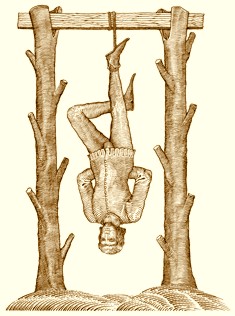

ARMAN HARMONIOUS HIGH CULTURE...INCLUDING ART AND MUSIC
THROUGH SPIRITUAL CLEANSING AND PURIFICATION LED TO SELF-REALIZATION...
...THE RAISED MICROCOSMIC CONSCIOUSNESS REUNITED THE HUMAN
[HIGH-MAN] FROM THE FALLEN STATE OF AMNESIA... WITH THE SOURCE.
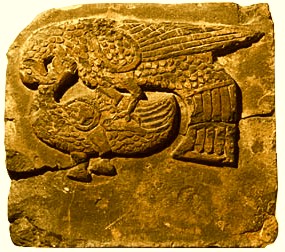
COAT OF ARMS OF THE VACHUTEAN PRINCES.
[TRANSFORMATION] FROM YOVHANNAVANK‛.
XIIITH
CENTURY. RENDITION BY G. KHANJIAN IMMEDIATELY ABOVE.

RELIEF OF AN EAGLE UPON LAMB FROM KECHARIS. XITH CENTURIES.
of the extent of the presence of the Armenian alchemists [busy in preparing ample samples of the elixir of immortality with their secret formula of the essential ingredient -- pierre d'Armenie also known as the Armenian Salt or the Philosopher's Stone] renowned for their hermetic art throughout Europe and the Near East during the Middle Ages.

GOLDEN EARRINGS MADE BY THE ARMENIAN MASTER GOLDSMITHS

GOLDEN NECKLACE MADE BY THE ARMENIAN MASTER GOLDSMITHS
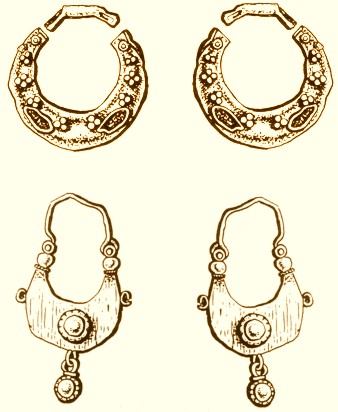
TOP ROW GOLD EARRINGS FROM EXCAVATIONS AT GARNI. FIRST CENTURY
AD.
BOTTOM ROW GOLD EARRINGS FROM EXCAVATIONS AT DVIN. SEVENTH CENTURY AD.
From the Ist century to the Vth century AD, Vałaršapat was the capital of Greater Armenia, under the rule of the Arsacid dynasty. In 428, the nakharars, blinded by their thirst for power, rose up against the monarchy. The rebellious nakharars succeeded in defeating the Royalists and were able to overthrow the Arsacid Royal House in 428 with the help of the Sassanians of Iran, who were more than happy to remove the Arsacid threat to their own power.

THE CITY OF DVIN HAD AN ELABORATE SEWAGE SYSTEM WHICH
KEPT THE CITY'S HYGIENE LEVELS IN A RELATIVELY SAFE LEVEL
After 428, Dvin fell into the jurisdiction of the naxarars, who moved the capital from the Royal Vałaršapat to Dvin, thus making the city the new capital of Armenia, governed by the feudal lords, usually by the leading representative of the Mamikonean House. According to the Ašxarhac‛oyc‛ or Geography, by the acclaimed VIIth century scholar and scientist, Anania Shirakatsi, the Vostan or provincial, suburban area along that of the main city of Dvin extended as far as the Province of Ayrarat [Ararat] of Greater Armenia (q.v.; Hübschmann, pp. 365-66). In the second half of the Vth century the Catholicosal Seat of the Holy See was transformed from Echmiadzin to the City of Dvin.
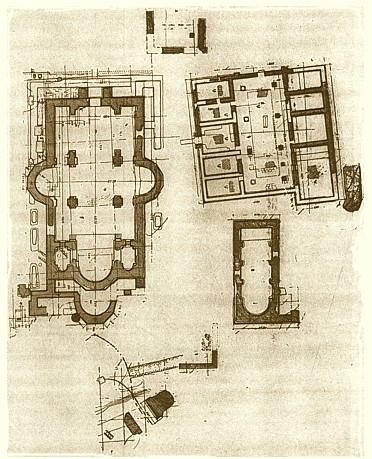
A SECTION OF THE CENTRAL QUARTER OF THE CITY
A number of synods were convened (the first in 505 or 506 AD, the second in 552 AD, 554 AD, or 555 AD; at the latter Council of Chalcedon was condemned and the specifically Armenian Calendar adopted; other synods were held in 604 AD, followed by 607 AD, 644 AD and 646 AD). As capital and economic and industrial center (particularly famed for “purple” carpets, q.v. ii) the City of Dvin prospered, quickly rising to become a very important international portal.
![]()
MARKINGS OF THE MASTER ARCHITECTS
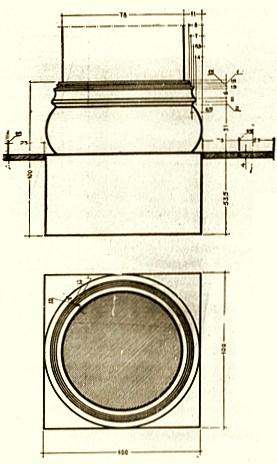
COLUMN BASE OF THE CATHOLICOSAL PALACE
The reputation of the local manufactures was still known to authors of the Islamic period. Sassanian efforts to restore the ancient religion of Armenia never ceased. The reconstruction of a Grand Fire Temple of Dvin led to a revolt of 571-572 AD, that became known as the Vahanac‛ War, named after the naxarar leader, General Vahan of the Mamikonean warrior nobility. The Same Mamikoneans were also in the forefront of the national resistance and the national liberation movement against foreign tyranny during the Vth century, led by the renowned General Vardan Mamikonean during the Vardanac‛ War.